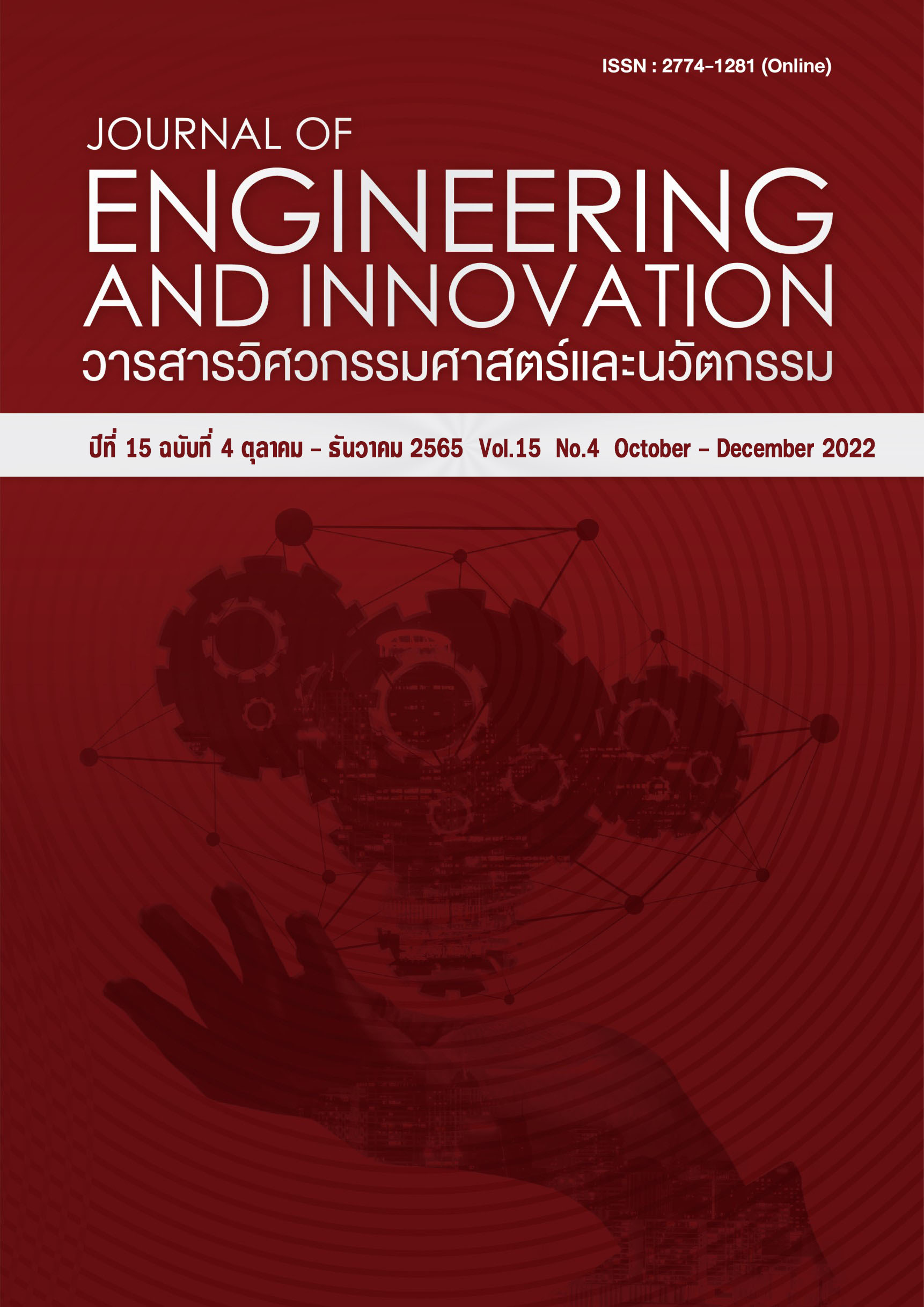ปัจจัยที่มีผลต่อความขรุขระผิวในการกลึงปอกอะลูมิเนียมเกรด 2024
Main Article Content
บทคัดย่อ
งานวิจัยนี้มีวัตถุประสงค์เพื่อศึกษาอิทธิพลของปัจจัยที่มีผลต่อความขรุขระผิวในการกลึงปอกอะลูมิเนียม เกรด 2024 โดยใช้เม็ดมีดกลึงคาร์ไบด์ ยี่ห้อ Plansee Tizit ชนิด DCGT 070204FN-27 เกรด H10T ปัจจัยที่ใช้ในการทดลองคือ ความเร็วรอบ อัตราป้อน และความลึกในการตัด วัสดุที่ใช้ในการทดลอง คือ อะลูมิเนียม เกรด 2024 ขนาดเส้นผ่านศูนย์กลาง 25 มิลลิเมตร โดยกำหนดขอบเขตการทดลองมีความเร็วรอบ 1,300, 1,500 และ 1,700 รอบต่อนาที อัตราป้อน 0.01, 0.03 และ 0.05 มิลลิเมตรต่อรอบ และความลึกในการตัด 0.1, 0.2 และ 0.3 มิลลิเมตร จากการทดลองพบว่า ปัจจัยที่ส่งผลต่อความขรุขระผิวคือ ความเร็วรอบ อัตราป้อน และความลึกในการตัด โดยค่าความขรุขระผิวมีแนวโน้มลดลงเมื่อใช้อัตราป้อน ความลึกในการตัดต่ำลง และเพิ่มความเร็วรอบสูงขึ้น และสามารถกำหนดสภาวะการกลึงด้วยสมการ Ra = 0.651 – 0.000295 Speed + 0.485 Depth + 2.77 Feed จากการทดลองเพื่อยืนยันผลเปรียบเทียบค่าที่ได้จากสมการกับค่าที่วัดจริงโดยกำหนดค่าความคลาดเคลื่อนของการพยากรณ์สำหรับค่าความขรุขระผิวไม่เกิน 5% ผลการทดลองหาค่าเฉลี่ยเปอร์เซ็นต์ค่าความคลาดเคลื่อนสัมบูรณ์ของสมการความขรุขระผิวเท่ากับ 3.15 % ซึ่งน้อยกว่าค่าความคลาดเคลื่อนที่กำหนดไว้ และค่าอยู่ในเกณฑ์ที่ยอมรับได้
Article Details
เอกสารอ้างอิง
Chayarun, M. Industrial materials. Bangkok: Charoen Tham Printing House. 2002. (in Thai)
Chulabuddee, P. and Saikaew, C. 2015. Study of Factors Affecting Surface Smoothness in Machining Process AISI 316L stainless steel by shinin experiment design. KKU ENGINEERING JOURNAL, 42 (1), 71-81. (in Thai)
Boonrod, W. and Ratanavilai, T. 2012. The Influence of Peeling Factors on the Surface Roughness of Semi-Solid Cast Aluminum. Substance Engineering Research and Development Issue, 23(4), 72-77. (in Thai)
Thonesangin, T. The Study of Influence of Liquid Nitrogen on Machining Properties of Stainless Steel SUS420. Master of Engineering Manufacturing Engineering Rajamangala University of Technology Thanyaburi, Bangkok, 2019. (in Thai)
Prasomthong, S., Namgaew, S., Saeong, M., Arunchai, T. and Udom, T. 2017, Study Parameter in The Turning Process on Surface Roughness of Austenitic Stainless Steels. the 14th National Kasetsart University Kamphaeng Saen: Proceeding, 273-280.
Krishnan, B. R., & Ramesh, M. 2020. Optimization of machining process parameters in CNC turning process of IS2062 E250 Steel using coated carbide cutting tool. Materials Today: Proceedings, 21, 346-350. (in Thai)
Naksenei, W. Study of Influence of Machining Conditions of Cold Work Tool Steel (SKD11) Turning with Titanium Coated Carbide Inserts on Surface Roughness. Department of Industrial Technology Rajabhat University, ChomBueng Village, 2010. (in Thai)
Waitrungrote, S. and Lawong, A. 2018. A Study of Turning Operation Factors Affecting Power Consumption. : Engineering Journal. Rajamangala Thanyaburi, 16(1), 13-21. (in Thai)
Rojananukul, C. and Wangwong, S. 2017. Surface Roughness Prediction in Turning Semi-Solid Cast Aluminum 5083 Using the Response Surface Method. National Operational Research 2017: Proceedings. 196-203. (in Thai)
Rojananukul, C. Homkhiew, C. and Wangwong, S. 2017. Surface Roughness Prediction in Turning of Aluminum Casting Semi-Solid Grade 2024 Using the Response Surface Methodology. IE Network 2019: Proceedings, 492-498. (in Thai)

